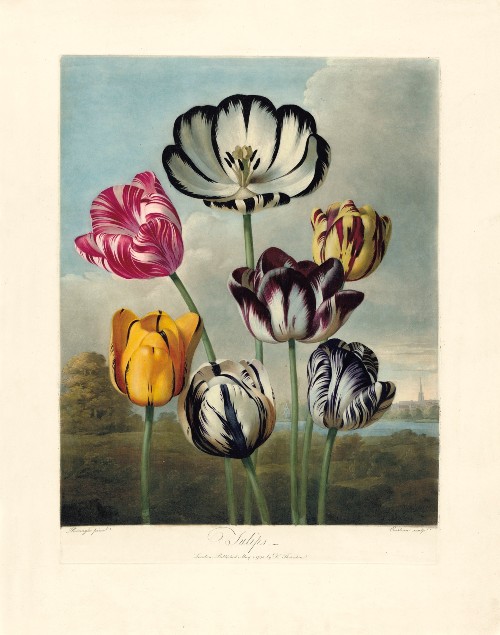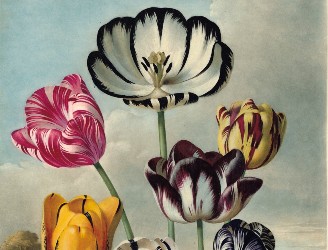
CHICAGO – Joel Oppenheimer Gallery will present an exhibition titled “Temple of Flora by Dr. Robert John Thornton,” which includes 33 original engravings. The show will run from April 24 to June 30.
Published in London from 1799–1807, Thornton’s magnum opus, Temple of Flora; or Garden of Nature: Picturesque Botanical Plates of the New Illustration of the Sexual System of Linnaeus, is an exquisite homage to Carl Linnaeus’ treatise on the sexual system of plants and considered by many to be the most famous of all florilegia. “As specialists in the antique natural history genre, we are pleased to exhibit such an influential and rare set of works from this fascinating period,” says Joel Oppenheimer.
Educated as a physician and botanist, Thornton devoted much of his adult life to creating his remarkable artistic tribute to the renowned Swedish botanist and taxonomist Carl Linnaeus. Employing the skills of eminent artists and artisans of the time, these engravings incorporate a masterful use of engraving techniques, including line, stipple and mezzotint applications at the pinnacle of the Golden Age of Natural History Art. Each flowering plant is depicted in a dramatic and often surreal setting that glorifies the aesthetic and exotic appeal of the subject while also extolling the imperial prowess of the British Empire at that time. The dramatic backgrounds feature romantic locales in the distant regions of the world to which these plants were native. This exhibit offers a unique opportunity to view this rare work in its entirety for the first time in the United States at the Joel Oppenheimer Gallery in Chicago.
Thornton’s Temple of Flora is perhaps the single most famous of all florilegia of the 19th century. As the driving force and visionary behind the creation of this great work, Thornton employed additional artists and engravers to produce it. Printed in color and finished by hand, a total of 70 plates were intended to be issued. Only 33 separate images of flowering plants were completed before the collapse of the project and Thornton’s financial demise, bankrupted by his fanatical pursuit of artistic perfection.
In 1804, a gallery was opened in London where the original paintings were exhibited, and catalogs of the works were offered in an effort to promote his ambitious publication. Having exhausted his personal financial resources, Thornton contrived an elaborate sales scheme to pay for the work. A license to hold an official lottery was obtained and all the works were sold as prizes.
The creation of Dr. Robert John Thornton’s opus, Temple of Flora, is intricately entwined with the history of botany, 18th century exploration, and the ensuing fascination with newly discovered exotic plant species brought back to Europe. As explorers traveled the globe, interest in collecting new species of plants increased and heightened the excitement surrounding all things botanical. Dr. Thornton came of age during this time of artists and botanists working together under royal patronage to describe, illustrate and celebrate newly discovered botanical wonders. Thornton was challenged to demonstrate Britain’s artistic superiority in this field.
Joel Oppenheimer Gallery is celebrating the 50th year as an art business based in Chicago. Rooted in the art conservation practice which was the inspiration for the founding of the business, the gallery services a nation-wide audience of private clients, museums, art galleries, and framers. Specializing in original natural history art from the 17th through 19th centuries, the gallery maintains an exceptional inventory of rare collectible artworks from that period.
_______
About Joel Oppenheimer Gallery
Joel Oppenheimer Gallery is celebrating the 50th year as an art business based in Chicago, Illinois. Rooted in the art conservation practice which was the inspiration for the founding of the business, the gallery services a nation-wide audience of private clients, museums, art galleries, and framers. Specializing in original natural history art from the 17th through 19th centuries, the gallery maintains an exceptional inventory of rare collectible artworks from that period.
About Oppenheimer Editions
Oppenheimer Editions is a fine art publishing arm that holds licensing agreements with important museums and libraries that have significant collections in our specialized field. Utilizing cutting edge digital technology, Oppenheimer Editions has pioneered the field of high-quality museum-authorized limited editions. Please visit https://www.audubonart.com for more information.



